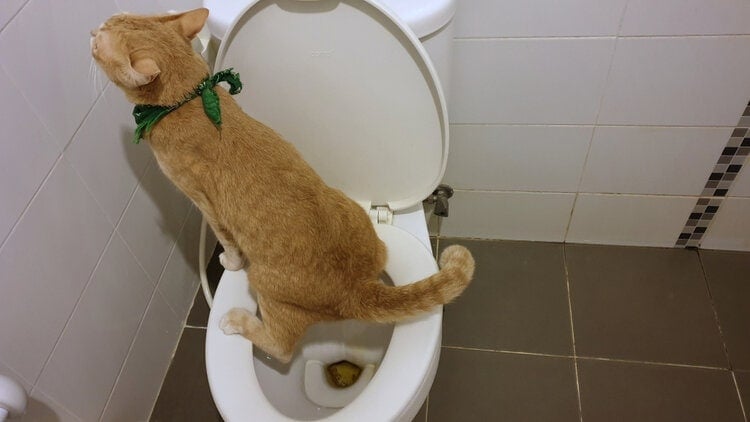Prevent Clogs and Damage: Never Flush Cat Poop Down Your Toilet - Professional Recommendations
Prevent Clogs and Damage: Never Flush Cat Poop Down Your Toilet - Professional Recommendations
Blog Article
This article listed below relating to Can You Flush Cat Poo or Litter Down the Toilet? is especially compelling. Don't miss it.

Introduction
As pet cat proprietors, it's essential to be mindful of exactly how we throw away our feline friends' waste. While it may seem hassle-free to purge feline poop down the bathroom, this technique can have detrimental consequences for both the environment and human health.
Environmental Impact
Purging cat poop presents hazardous virus and parasites right into the water supply, posing a substantial risk to marine communities. These impurities can negatively influence marine life and concession water top quality.
Health Risks
Along with ecological problems, purging pet cat waste can additionally present health and wellness dangers to people. Feline feces may include Toxoplasma gondii, a parasite that can cause toxoplasmosis-- a potentially severe illness, particularly for expectant women and people with damaged body immune systems.
Alternatives to Flushing
The good news is, there are much safer and much more responsible means to dispose of feline poop. Take into consideration the complying with options:
1. Scoop and Dispose in Trash
The most common approach of throwing away feline poop is to scoop it into a biodegradable bag and toss it in the trash. Be sure to utilize a committed trash inside story and take care of the waste promptly.
2. Use Biodegradable Litter
Select eco-friendly feline litter made from products such as corn or wheat. These clutters are environmentally friendly and can be safely disposed of in the trash.
3. Bury in the Yard
If you have a yard, take into consideration burying pet cat waste in a marked location far from vegetable gardens and water resources. Be sure to dig deep adequate to avoid contamination of groundwater.
4. Mount a Pet Waste Disposal System
Buy a pet waste disposal system particularly created for feline waste. These systems use enzymes to break down the waste, minimizing odor and environmental impact.
Final thought
Liable pet possession extends beyond giving food and shelter-- it likewise involves appropriate waste monitoring. By refraining from purging feline poop down the commode and opting for alternate disposal methods, we can decrease our environmental footprint and protect human health and wellness.
Why You Should NEVER Flush Cat Poop (and/or Litter) Down Your Toilet
The Problem with Litter
The main function of litter is to solidify and adhere to your cat’s waste. While this makes litter excellent for collecting cat poop and urine, it’s also the exact property that makes it a nightmare when flushed down the toilet.
Cat litter can and will clog pipes. There is non-clumping litter, but it’s still quite heavy and can build up in pipes. This is true even of supposed “flushable litter.”
The problems only compound when the litter is already clumped into cat waste. Toilet paper is among the more flushable things, and even too much of that will clog a toilet.
The Problem with Cat Poop
Sewers and septic systems are designed with human waste in mind. The microbes that help break down human waste don’t work on cat waste. Additionally, cat poop plays host to the parasite Toxoplasma gondii.
When flushed, this parasite can enter the environment in places it was never meant to, posing a risk to pregnant women, their unborn children, and other people with compromised immune systems. While it might not seem possible, flushing cat poop can indeed introduce this parasite to the public water supply.
These reasons are why, even if you’ve trained your cat to go on the toilet and flush, which is possible, it’s still not a good idea. Also, pregnant women and the immunocompromised shouldn’t change litter, either.
How to Handle Litter
The best way to handle litter is to simply put it in a plastic bag and place it in the trash. Avoiding environmental risks and possible plumbing damage is worth the extra effort.
You can also invest in devices that seal away your cat’s waste in a separate compartment, so you don’t have to change the litter nearly as often. They’re also safer for pet owners because they limit the possibility of Toxoplasma gondii exposure.
Disposing of litter the old-fashioned way will ensure you won’t have to worry about any issues that flushing the waste can potentially cause.
Take Care of Clogged Pipes with Stephens Plumbing, Heating & Air Conditioning
The reasons you should never flush cat poop down your toilet are numerous, but sometimes the inevitable happens despite your best efforts.
Stephens Plumbing, Heating & Air Conditioning is ready to help if you’re experiencing litter-blocked plumbing. Whether you need us in an emergency or want to schedule regular maintenance, we’re here for you.
https://www.stephensplumbing.net/bathroom-plumbing/never-flush-cat-poop-down-your-toilet/

I hope you enjoyed reading our post about How to Dispose of Cat Poop and Litter Without Plastic Bags. Thanks a lot for taking the time to read our blog post. Those who enjoyed our blog post kindly remember to pass it around. I love reading our article about How to Dispose of Cat Poop and Litter Without Plastic Bags.
Book Service Report this page